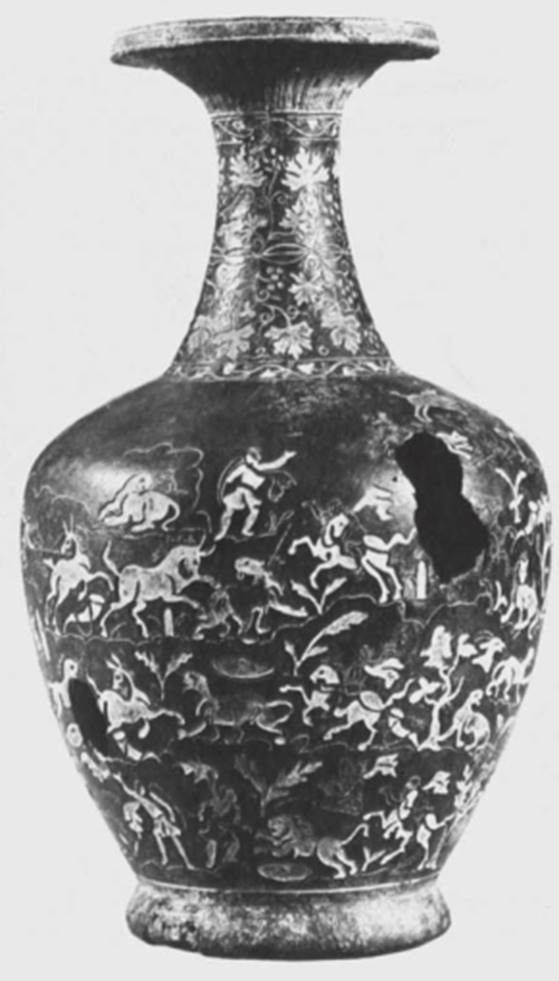Pitcher with hunting scenes. Italy (?), 2nd half 4th century. Bronze with silver, copper, and niello inlay
The pitcher is divided into three decorated zones by continuous lathe-cut lines. Much of the precious inlay has either fallen, or was pried, out. Random parts of the fabric, especially on the shoulder and neck, are missing.
Under the wide flaring lip is a radiate linear pattern. The neck, bordered by continuous ivy vine scrolls, is decorated with inlaid grapevines, leaves and clusters emanating from a lenticular band. The body is decorated with hunting scenes arranged in irregular registers; the figures are executed in both solid areas and inlaid line, producing a vivid, coloristic impression.

The hunting scenes are traditional encounters between hunters and animals (felines, deer, wild horses, boar). The landscape setting is indicated by an uneven groundline, which the figures sometimes do and sometimes do not meet; gnarled, large-leaved trees and grass as well as scattered shields and hunting horns serve as space fillers. There is a notable attempt to suggest depth by showing figures from behind, in three-quarter twists, and hunters and animals partially concealed behind outcroppings. However, the highly activated lines and the contrast of colored metals produce an overall silhouettelike effect,;. emphasizing the decorative qualities of the scintillating surface.
This metal inlay piece is related by technique to a small group of objects recently discussed by Bielefeld (1972). These include the Louvre hunt plaque (no. 77) and charioteer (no. 94). One remarkable member of this group is a throne back in the Archaeological Museum in Florence (Minto, 1935-1936) where the cross on one of the hunters' shields places the iconographically and stylistically closely related group into post-Constantinian times. The excavation of the Florence throne on Italian soil and the purchase of this pitcher and the Louvre plaque in Rome support the likelihood that these bronze pieces were made in central Italy, if not actually in Rome.
These hunts bear great affinities to the hunting and pastoral scenes on the seaside palace plate from Augst (no. 251) and the Cesena plate (no. 251a), both executed with niello and gilt. These similarities point to a date for this pitcher around the middle of the fourth century or slightly later. Bibliography: Minto, 1935-1936, pp.. 133-134; Bielefeld, 1972, pp. 426-428; Kleinbauer (1), 1976 p. 23, fig. p. 26.
Date added: 2025-07-10; views: 154;
